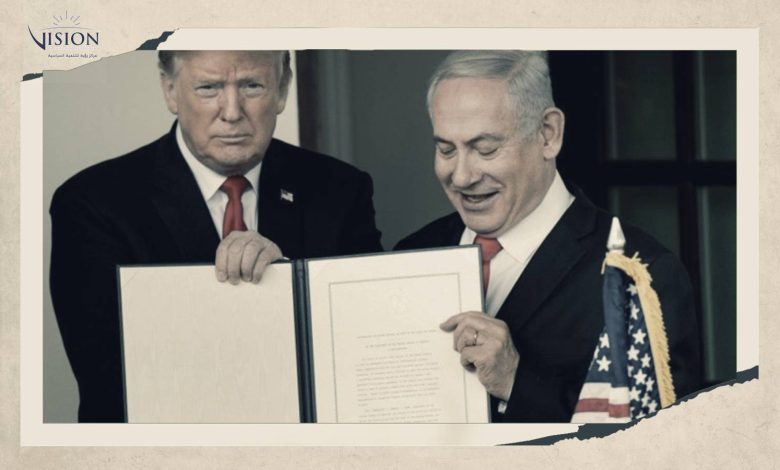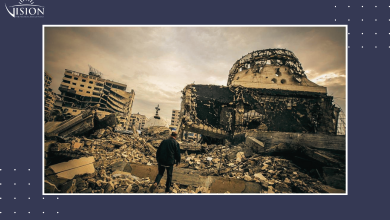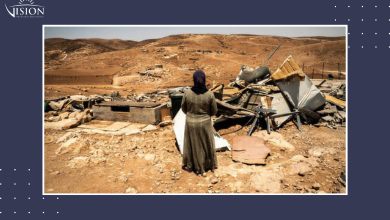Will Trump’s Return Herald the Annexation of the West Bank?

By Karim Qurt
The announcement of Donald Trump’s victory in the U.S. presidential elections has reignited a cascade of questions and concerns regarding his anticipated policies, especially in the wake of the genocidal war on Gaza, its spillover into Lebanon, and the intensifying confrontation between Iran and its allies on one side and the Israeli occupation on the other. Among these pressing issues, there is a particularly critical question: Trump’s potential stance on the Palestinian cause, particularly the annexation of the West Bank and the possibility of reviving the so-called “Deal of the Century.”
This dilemma has fueled profound inquiries within Palestinian circles: Will Trump resurrect the “Deal of the Century,” once proposing a fragmented Palestinian state confined to parts of the West Bank and Gaza Strip? Or has that deal been abandoned altogether? Might the occupation government embark on annexing the entire West Bank outright? Or could it begin by annexing the Jordan Valley, Area C, and major settlement blocs like Ma’ale Adumim and Ariel? Perhaps it will go even further, incorporating all settlements and unauthorized outposts?
This debate transcends theoretical speculation; it is deeply rooted in the historical trajectory of Trump’s first administration. That administration made unprecedented moves, including recognizing Jerusalem in its entirety as the capital of “Israel,” relocating the U.S. Embassy there, acknowledging Israeli sovereignty over the occupied Syrian Golan Heights, and declaring that West Bank settlements no longer violate international law—a stance only partially reversed by the Biden administration. Additionally, Trump actively championed normalization between several Arab regimes and the occupying state. Most significantly, he unveiled the “Peace to Prosperity” plan, infamously known as the “Deal of the Century,” which explicitly endorsed annexing large swathes of the West Bank, including Area C and settlements. This plan, though never implemented due to various complexities, served as a blueprint for entrenching Israeli dominance.
Under the Biden administration, the foundation laid by Trump has remained largely unshaken. Not only did Biden refrain from reversing most of Trump’s policies toward the Palestinian cause, but he also doubled down on consolidating normalization efforts, particularly with Saudi Arabia. Furthermore, the Biden administration has played an instrumental role in supporting the genocidal campaign in Gaza—militarily, financially, politically, and through relentless propaganda.
Recent developments lend further credence to the discussion surrounding Trump’s potential policies. Reports indicate that Israeli billionaire Miriam Adelson has pledged financial and political backing for Trump’s campaign in exchange for advancing a comprehensive annexation plan for the West Bank. Simultaneously, figures slated for key roles in Trump’s prospective administration are openly aligned with annexationist ideologies. Meanwhile, Israeli leaders have been quick to signal their readiness to execute annexation schemes should Trump assume office.
This report endeavors to unravel these pressing questions by emphasizing a pivotal reality: annexation is not confined to formal declarations. It is, in fact, a sustained, methodical process, normalized as a daily practice that often escapes scrutiny. What is unfolding on the ground—rather than official pronouncements—defines the future of the West Bank and the broader Palestinian cause. It is the entrenched realities on the ground that dictate the trajectory, rendering official acknowledgments as mere affirmations of the facts imposed through systematic dispossession and de facto annexation.
Settlers Rejoice at Trump’s Return
In addition to Israeli Prime Minister Benjamin Netanyahu, who was quick to congratulate Donald Trump on his election victory, Yossi Dagan, head of the West Bank Settlements Council, was among the first to extend his congratulations to Trump. Dagan has also been invited to attend Trump’s inauguration ceremony on January 20th. The settlers leans towards Trump’s administration on several fronts, chief among them being the facilitation of imposing Israeli sovereignty over parts of the West Bank, such as the Jordan Valley and major settlement blocs, or even the entirety of the West Bank. They are also expected to demand the repeal of all sanctions imposed by the Biden administration on certain settlements and settlement organizations, as well as seeking Trump’s political and legal support for settlement expansion in northern Gaza.
To achieve these objectives, leaders of the West Bank settler movement have recently intensified their efforts to strengthen ties with key figures within the Republican Party and Trump’s inner circle, particularly members of his former administration, such as former Secretary of State Mike Pompeo and former U.S. Ambassador to Israel David Friedman. Both were hosted by settlers in the West Bank settlements in recent months.
Following the announcement of Trump’s victory, several Israeli officials immediately began discussing the prospect of annexing the West Bank. According to Israeli public broadcaster Kan, Netanyahu plans to place the annexation of the West Bank on his government’s agenda as soon as Trump assumes office. He has also held consultations with settler leaders and opposition leader Benny Gantz regarding the opportunity presented by Trump’s return to advance annexation plans. Gantz has expressed his support for the annexation, calling it a “historic opportunity that must not be missed.”
Finance Minister and Minister in the Israeli Ministry of Defense, Bezalel Smotrich, also hurried to congratulate Trump during a conference of the Religious Zionism faction in the Knesset. Smotrich declared that Trump’s victory brings a significant opportunity for the State of Israel, stating that “the time has come to impose Israeli sovereignty over the settlements in the West Bank.” He emphasized that there is unanimous opposition across Israel’s political spectrum, both in the coalition and opposition, to the establishment of a Palestinian state. He went further, announcing that 2025 will be the “Year of Sovereignty” in the West Bank. Smotrich revealed that he had already instructed the Settlement Division in the Ministry of Defense and the Civil Administration to begin comprehensive steps to prepare the necessary infrastructure for declaring annexation.
However, despite the overwhelming enthusiasm and high expectations tied to Trump’s administration, some initial concerns arose among settlers. They feared that Trump might appoint figures to his administration who are not staunch supporters of Israel and its settlement enterprise, given his wide-ranging domestic and international priorities. These concerns were particularly amplified by the absence of figures such as Mike Pompeo and other key members of Trump’s first administration from the political scene. Nonetheless, the series of appointments Trump has announced has dispelled these doubts, reassuring the settlers that his second administration will not deviate from the policies of the first. The presence of “friends of Israel” in key positions within Trump’s administration has solidified their confidence that this presidency will further advance the interests of the Israeli occupation across many dimensions.
Because those filling the most critical seats in Trump’s administration are among the strongest supporters of the occupying state, staunch opponents of Iran, and enthusiastic backers of the settlement project in the West Bank—particularly Mike Huckabee, the incoming U.S. ambassador to the occupying state, a friend of the settlers, a frequent visitor to settlements, and a tour guide for evangelical delegations in the West Bank.
Settlers: No Palestinian State, Even in Exchange for Annexation
Despite the overwhelming optimism among the leaders of the occupation and its settlers over Trump’s return and the appointment of “friends of Israel” in his administration, doubts remain. Chief among these is the concern that Trump’s focus may shift to brokering a deal with Saudi Arabia, which could involve agreeing to the establishment of a “Palestinian state.” This issue is perhaps the primary reason—if not the most significant—for the failure to implement the Deal of the Century during Trump’s first administration.
It is true that one of the main reasons the deal was not implemented at the time was the lack of Palestinian consent—neither from the Palestinian Authority in the West Bank nor from Hamas in the Gaza Strip. Naturally, without such consent, its implementation was impossible, particularly since the plan required the disarmament of the resistance in Gaza and the presence of a Palestinian party willing to relinquish Jerusalem and the West Bank. This was an unthinkable prospect for any Palestinian leadership. Moreover, as Trump later stated, Netanyahu never intended to pursue peace with the Palestinians, effectively rejecting the deal outright. This is a widely understood reality, as no Israeli official would ever agree to the establishment of a Palestinian state.
When the Deal of the Century was proposed, its primary opponents were the settlers and their leaders. Those few among them who supported the deal did so only because they viewed it as a long-awaited historical opportunity, merely a first step toward annexation. The opposition, however, stemmed from an absolute rejection of the establishment of any form of Palestinian state, regardless of its nature. Additionally, there was strong objection to the plan’s stipulation of freezing settlement construction and to the existence of settlement enclaves that would remain outside the boundaries of the occupying state within the proposed “Palestinian state.”
To elaborate further, the settlers categorically refuse to concede even an inch of land to the Palestinians, considering the entirety of the West Bank an inseparable part of “Eretz Israel.” For this reason, they rejected the plan then and will continue to reject it in the future, particularly as settler-affiliated parties have become an influential and decisive force in shaping the policies of the occupying government.
Therefore, it is certain that the settlers and their leaders will reject any settlement proposed by Trump as part of a normalization deal between Saudi Arabia and Israel that includes references to the establishment of a Palestinian state, regardless of its nature. This rejection, given the current government and the growing influence of the Hardali right, has become the dominant and decisive factor in the policies of the occupation governments.
However, on the whole, settlers will not oppose a formal declaration of annexation of parts of the West Bank, provided it is not tied to any political process related to a two-state solution. Their view is that such partial annexation would constitute another step toward settlement expansion and full annexation. Compared to the United Arab Emirates’ announcement in 2020 that it normalized relations with Israel to halt annexation, it is conceivable that some form of compromise could occur in the pursuit of a Saudi-Israeli normalization deal. Saudi Arabia, in need of even a symbolic achievement on the Palestinian issue, might announce normalization in exchange for halting the annexation of the West Bank.
Annexation Is Already Happening
What matters is not whether there will be a formal announcement of annexation, nor its scope, but rather the realities being created on the ground and the de facto policies that have been implemented for decades. Annexation and displacement policies have been ongoing since the occupation of the 1967 territories, accelerating significantly in recent years and peaking during the genocidal war on Gaza. This has included various measures such as the expansion of settlement construction, the establishment of settlement outposts, and efforts to legalize them. Since the start of the war on Gaza, 43 new settlement outposts have been established in the West Bank, breaking all previous records. From 1996 to 2023, an average of seven new outposts were established annually. In June 2024, the occupation government announced plans to legalize 70 settlement outposts, reclassify three others as neighborhoods of existing settlements, and establish five new settlements—these were already existing outposts but were officially reclassified as settlements. Notably, the occupying state officially ceased establishing new settlements after the Oslo Accords, except in specific cases, but continued expanding existing settlements, supporting outposts, and incorporating them as neighborhoods into established settlements. This has been accompanied by massive budgets allocated for settlements and outposts, providing them with infrastructure such as roads, water, electricity, and security.
In addition, there has been an unprecedented surge in the declaration of “state lands. {1}” Since the start of the genocidal war, more than 24,000 dunams have been declared state lands, a figure equivalent to half of all such declarations made from 1993 to 2023.
On another front, Smotrich has undertaken several administrative and legal measures aimed at transferring authority over settlement affairs and the civil administration in the West Bank to settlers, removing it from the jurisdiction of the occupying army. These steps are seen as a de facto annexation of the West Bank without the need for an official announcement. Smotrich himself stated that even if the government were to fall, these measures have fundamentally changed the DNA of the civil administration by stripping it of military control and redirecting it to serve the annexation and settlement agenda. Settlers believe the occupying army has been a significant obstacle to the settlement project.
Another particularly dangerous and critical development is the intensification of Palestinian displacement from their lands in the West Bank. In recent years, efforts have focused on Bedouin communities, particularly in the Jordan Valley from the northern to the southern West Bank, the southern Hebron hills, and central West Bank regions. Since the outbreak of the Gaza war, the pace of displacement targeting Bedouin communities across the West Bank has reached alarming levels, aiming to empty Area C of any Arab presence. This has led to the displacement of dozens of Bedouin communities, while the remaining communities continue to face daily assaults and violations designed to drive them off their lands.
To clarify this demographic shift, we must rely on approximate data, which, while not entirely precise due to the absence of formal statistics of this nature, are nonetheless critical in illustrating the dynamics at play.{2}
In 1967, approximately 65% of the population in the West Bank resided in villages, a figure that included Bedouins and inhabitants of wilderness areas, who constituted no more than 1.5% of the population at the time. Meanwhile, the proportion of urban residents—defined as individuals living in cities with populations exceeding 10,000—was roughly 26%. Refugees in camps accounted for about 9.4% of the total population. Since these camps were scattered across urban and rural areas and their peripheries, we can divide their proportion between cities and villages to reach an approximate distribution: about 70% of the population lived in villages and rural areas, while 30% resided in urban or metropolitan regions.{3}
This ratio has shifted dramatically in recent years, essentially reversing. According to data from the United Nations Human Settlements Programme (UN-Habitat) from 2015, covering both the West Bank and Gaza, around 74% of Palestinians now reside in urban areas, while the remaining 26% live in villages and rural regions.
While these statistics do not specify the characteristics of urban areas or distinguish between Areas A and B, it is evident that population density is increasingly concentrated in Area A. This trend can be attributed to various factors, including employment opportunities, educational and healthcare services, and the need to avoid the constraints of occupation, settler violence, and other pressures. This pattern of migration has continued to escalate, effectively leaving vast portions of the West Bank—primarily Area C—largely depopulated of Palestinians, with only small, isolated communities remaining. These communities are encircled by settlements and checkpoints, subjected to relentless settler violence and intimidation.
Ultimately, it is crucial to recognize that an ongoing process of internal displacement is unfolding. Area C has already been effectively emptied of much of its Palestinian population, and now Area B is experiencing similar pressures, forcing residents to migrate toward urban centers in Area A. This displacement is an integral component of the annexation strategy and settlement expansion agenda. Thus, whether or not a formal announcement is made regarding the annexation of the West Bank under a potential Trump administration, the reality on the ground remains the primary concern, as it continues to be dictated by policies of dispossession and de facto annexation.
Conclusion
The most pressing concern for Palestinians and other stakeholders in the region is not merely the return of Donald Trump to power, nor whether he will support annexation or revive the Deal of the Century. Rather, it is the rapid and ongoing changes on the ground that systematically advance de facto annexation and the silent displacement of Palestinians from their lands. These developments, deeply entrenched in the daily realities of the West Bank, have persisted for decades. While their pace has significantly accelerated in recent years, particularly in the past year, this escalation has become normalized, drawing little attention. Silent displacements, incessant attacks on Palestinian villages, settlement expansion, and land confiscation now constitute the fundamental infrastructure for annexation.
When the Deal of the Century and annexation proposals were previously introduced, Gaza’s resistance forces could actively object and reject the disarmament conditions. However, at this stage, Gaza faces a continuous campaign of extermination, targeting its very existence rather than just its armament. This has severely curtailed its capacity to influence or resist. Similarly, the Palestinian Authority, which had previously been capable of maneuvering and voicing opposition, now faces existential threats of dissolution and collapse. These compounded challenges render the current circumstances far more critical than the previous iteration of these plans.
At present, the region remains engulfed in escalating conflict, with no clear resolution achieved by any party. The outcomes of this ongoing war, and the subsequent developments, will ultimately dictate the agenda of a potential Trump administration and the policy directions of the Israeli occupation government.
Footnote 1: The occupation authorities employ manipulative legal tactics to confiscate land in the West Bank, including declaring lands as “state lands” through a deceptive application of the Ottoman Land Law of 1858. This law categorized land into several classifications, including communal, state-owned, and barren lands. The occupation authorities have re-applied this law in the West Bank, using it to seize approximately one-quarter of its land, which has since been allocated for settlements and settler use.
Footnote 2: The researcher was unable to access more precise data from open sources due to the significant challenges in analyzing the demographic shifts and redistribution of the population within the West Bank. This complexity stems from the inherently problematic nature of population censuses in the West Bank, which have been influenced by various considerations and obstacles since before 1967, during the Jordanian administration, and subsequently under Israeli occupation. Even in recent times, under the Palestinian Authority, the Central Bureau of Statistics—a highly active and competent institution—operates with a statehood perspective or what might be termed the “illusion of statehood.” Its population statistics do not account for the fact that its jurisdiction is over an occupied, politically, administratively, and geographically fragmented territory, divided into Areas A, B, and C. These divisions are continually subject to demographic and urban transformation, complicating an accurate analysis of population distribution across these zones.
The statistics provided by the Central Bureau of Statistics fail to account for the complex political and geographical realities of the West Bank. Instead, they operate under the assumption that the entirety of the territory is under Palestinian control. Consequently, these statistics present population distributions based on governorates, depicted in their entirety without reflecting the Oslo Accords’ divisions. There is no breakdown of population distribution within each governorate, despite the well-established fact that all governorates are segmented into Areas A, B, and C, with Area C often constituting the majority of their land area.
This approach results in a misleading understanding of several critical issues, including the actual population density in the West Bank. The general definition of population density cannot be meaningfully applied to a region like the West Bank, which is fragmented politically and administratively under a continuously evolving colonial framework. More critically, this statistical approach obscures an accurate understanding of the geographical and demographic transformations, particularly the displacement of populations from Areas C and B into Area A.
Footnote 3: Jamil Hilal, “The Impact of Politics on the Demographic Situation in the West Bank and Gaza Strip,” Palestinian Studies, Issue 4 (Autumn 1990), pp. 133–150. Link.





